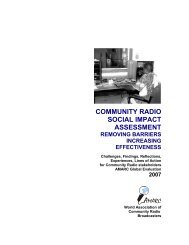WHAT IS COMMUNITY RADIO - amarc
WHAT IS COMMUNITY RADIO - amarc
WHAT IS COMMUNITY RADIO - amarc
Create successful ePaper yourself
Turn your PDF publications into a flip-book with our unique Google optimized e-Paper software.
Appendix three - EQUIPMENT INFORMATION FOR SETTING UP<br />
These guidelines were prepared by Kodjo Nyamaku, a Togolese radio-broadcasting engineer, for the<br />
NCRF and the African community radio movement.<br />
The technical development of a Community Radio Station usually follows a series of consecutive<br />
steps.<br />
Procedure 1<br />
Carry out a survey to assess potential listenership and calculate feasibility.<br />
The following points should be clarified:<br />
� How big is the locality radius you attended to cover, this would help to define the power of the<br />
transmitter needed. The average coverage radius for difference effective heights is as follows:<br />
Effective height above average terrain 75 m<br />
Stereo Service<br />
10 W approx. 5 km<br />
100 W approx. 11 km<br />
1000 W approx. 18 km<br />
Effective height above average terrain 150 m<br />
10 W approx. 8 km<br />
100 W approx. 15 km<br />
1000 W approx. 25 km<br />
These figures depend very much on the terrain of the coverage area. There might be bad reception<br />
within these areas if there are hills, mountains or sea. There is a good reception within a flat area.<br />
� Where the station will be located to facilitate community access.<br />
� Obtaining a topologic map of the area showing hills, mountains, valleys, rivers, etc., to determine<br />
the best position for the antenna. This should be close to the station to avoid the need of a link up<br />
system from the studio to the antenna.<br />
� Looking for radio broadcast equipment suppliers to get different quotations. The choice of the<br />
supplier should be made by taking a particular attention on the technical performance of the<br />
suppliers described above. It is helpful to choose a local or regional supplier.<br />
� Deciding, according to the nature of the programmes format, whether the studio should be divided<br />
or not by a glass partition between the controller’s and presenters’ areas.<br />
A technician, who should pay a visit to the locality, should help clarify those points.<br />
Procedure 2<br />
� The supplier produces a report for radio broadcasting/production studio equipment (including<br />
transmitter) by taking into account the available skills involving in the project.<br />
� The supplier produces a suitable, comfortable and ergonomically studio layout plan, taking into<br />
accounts the size of the room and the needs of in-house training and potentially large production<br />
teams (e.g. spatial arrangement of equipment, workspace, ventilation, etc.).<br />
� Draw the budget<br />
Procedure 3<br />
40<br />
What is Community Radio? A Resource Guide<br />
Published by AMARC Africa and Panos Southern Africa in collaboration with IB<strong>IS</strong>/Interfund and WACC

















